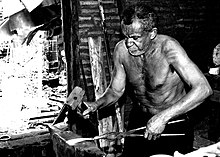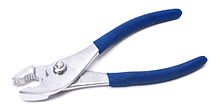Pliers
This article needs additional citations for verification. (April 2009) |



Pliers are a
Diagonal pliers, also called side cutters, are a similarly shaped tool used for cutting rather than holding, having a pair of stout blades, similar to
Parallel pliers have jaws that close in parallel to each other, as opposed to the scissor-type action of traditional pliers. They use a box joint system to do this, and it allows them to generate more grip from friction on square and hexagonal fastenings.[2]
There are many kinds of pliers made for various general and specific purposes.
History

As pliers in the general sense are an ancient and simple
Design
The basic design of pliers has changed little since their origins, with the pair of handles, the pivot (often formed by a rivet), and the head section with the gripping jaws or cutting edges forming the three elements.
The materials used to make pliers consist mainly of
A plier-like tool designed for cutting wires is often called diagonal pliers. Some pliers for electrical work are fitted with wire-cutter blades either built into the jaws or on the handles just below the pivot.
Where it is necessary to avoid scratching or damaging the workpiece, as for example in
over the jaws are used.Ergonomics
Much research has been undertaken to improve the design of pliers, to make them easier to use in often difficult circumstances (such as restricted spaces). The handles can be bent, for example, so that the load applied by the hand is aligned with the arm, rather than at an angle, thus reducing muscle fatigue. It is especially important for factory workers who use pliers continuously and helps prevent carpal tunnel syndrome.
Types
-
Diagonal pliers or side cutters
-
Lineman's pliers or combination pliers
-
Bent nose pliers
-
Pincers
-
Electrical wire stripping and terminal crimping pliers
-
Crimptool for N, R-SMA, TNC connectors for RG174, RG58 and HDF/LMR200
-
Heavy duty crimping pliers forRJheads
-
Hand crimp tool
-
Tongue-and-groove pliers, also known as channel-locks after the Channellock brand
-
Locking pliers, also known as a vise-grip
-
Circlip pliers, for fitting and removing retaining rings
-
Round-nose pliers, for making loops in wires
-
Wiper pliers used to adjust the wipers and spring-sets on electro-mechanical relays.
-
Contemporary 'Pliers Wrench' with high mechanical advantage parallel-gripping jaws.
See also
References
- ^ a b "Hand Tools:Tongs, pincers, and pliers". Encyclopædia Britannica. Retrieved 14 March 2013.
- ^ "What are parallel pliers and how do they work?". Maun Industries. Retrieved 27 April 2023.
- ^ Bellis, Mary. "The History of Hardware Tools". Inventors.About.com. Accessed 16 December 2008.
- ^ Warre Cornish, Francis (1898). A Concise Dictionary of Greek and Roman Antiquities. London: Spottiswoode & Co. p. 313.
External links
- How pliers are made Archived 29 March 2013 at the Wayback Machine (video)
- Types of Pliers










